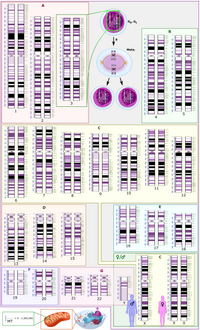
Photo from wikipedia
Cadaveric simulation models allow researchers to study native tissues in situ. However, as tests are conducted using donor specimens with unmatched kinematics, techniques that impose population average motions are subject… Click to show full abstract
Cadaveric simulation models allow researchers to study native tissues in situ. However, as tests are conducted using donor specimens with unmatched kinematics, techniques that impose population average motions are subject to deviation from true physiologic conditions. This study aimed to identify factors which explain the kinetic variability observed during robotic simulations of a single human gait motion using a sample of human cadaver knees. Twelve human cadaver limbs (58 ± 16 years) were subjected to tibiofemoral geometrical analysis and cyclical stiffness testing in each anatomical degree of freedom. A simulated gait motion was then applied to each specimen. Resulting kinetics, specimen geometries, and various representations of tissue stiffness were reduced to functional attributes using principal component analysis and fit to a generalized linear prediction model. The capacity of knee topography to generate force was the largest contributor to kinetic variation in compression. Overall joint size, femoral notch height, translational laxity, and ad/abduction stiffness significantly contributed to kinetic variation in medial/lateral and anterior/posterior forces and associated torques. Future studies will investigate customizing kinematic paths to better simulate native conditions and reduce sampling variation, improving biomechanical test methods and evaluation strategies for future orthopedic techniques.
Journal Title: Annals of Biomedical Engineering
Year Published: 2017
Link to full text (if available)
Share on Social Media: Sign Up to like & get
recommendations!